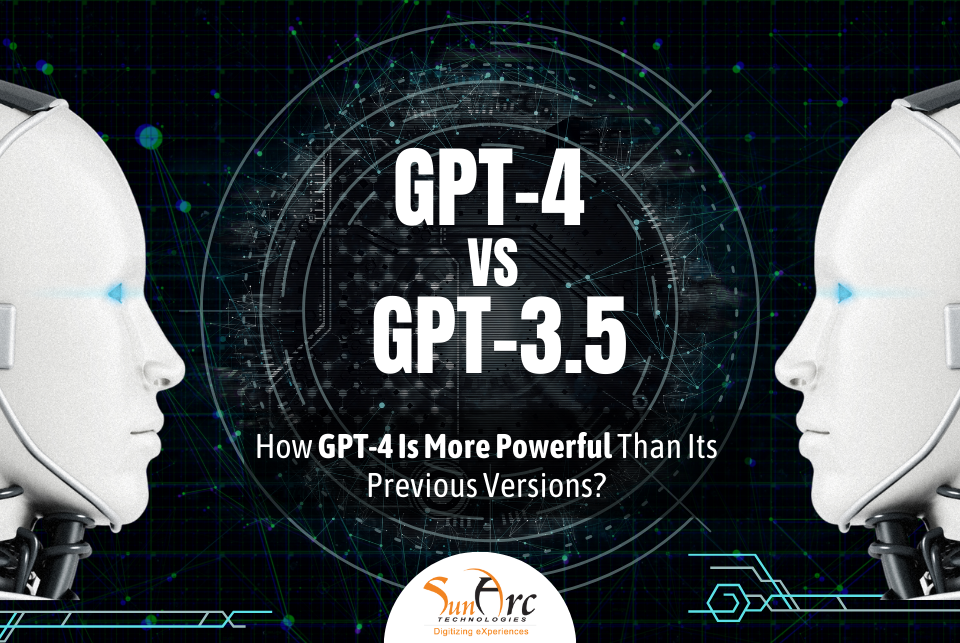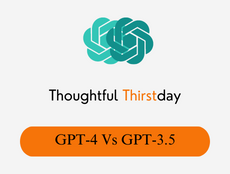The GPT models developed by OpenAI have already made waves in the industry, and the release of GPT-4 has grabbed some further attention.
OpenAI’s most powerful system to date, the GPT-4, has been unveiled, and it has improved upon earlier versions in both general knowledge and problem-solving ability.
Both GPT 3.5 and GPT 4 have been met with mixed reactions from the market. Many have claimed that GPT-4 has the same limitations as GPT-3.5. On the other hand, many users cited that GPT-4 significantly improved over prior versions. Moreover, several users have reported that GPT-3.5 is noticeably quicker than GPT-4. This blog post will clarify the distinction between GPT-4 and GPT in the hopes of clearing up any lingering misconceptions.
There are three different groups of ChatGPT users: those who have only used version 3.5, those who have transitioned directly to version 4, and those who have used both versions. When each user examines GPT from their own perspective, they each arrive at their own unique conclusion (they’re right on their own points).
In contrast, accurate information is crucial for viewers who have just read these terms and will be regular users of GPT in the future.
This blog post will clarify everything for you, whether to go with GPT-3.5 or GPT-4. To explore the previous version you can go through our blog on GPT-3.5.

Let’s dive deeper and see what exactly the difference is between GPT-4 and GPT 3.5.
Key Differences Between GPT-4 And GPT-3.5
1. Multimodal Inputs
The first difference between GPT-4 and GPT-3.5 is the input handling. GPT-4 is more sophisticated than its predecessor, GPT-3.5, which relied solely on text input to produce the output. GPT-4 can produce text results by submitting just the images apart from the text. In addition, GPT-4 can interpret a sketch of a website’s framework and produce its corresponding source code.
OpenAI also provided a demonstration, including an image and a request to the chatbot to describe what was humorous about the provided input. Unlike its predecessor, GPT-3.5, GPT-4 can interpret photos and provide users with a written answer that is appropriate to the given context.
2. Improved Intelligence and Precision
With the GPT-4 launch, OpenAi said that the new LLM’s increased data and memory capacity gave it improved intelligence, reasoning, and the ability to provide more detailed findings. Because of the increased number of training data points, GPT-4 “is 82% less likely to reply to requests for banned content and 40% more likely to deliver factual replies than GPT-3.5,” as stated on the company’s official page.
Besides, GPT-4 can accept longer inputs which in turn provide lengthier or deep researched results.
Read more: 7 Best ChatGPT Chrome Extensions For 2023
3. Expanded Storage and Data Capacity
However, OpenAI has yet to disclose how many data points were used to train GPT-4. But it is significantly trained on more data than GPT-3.5. As per the industry experts, GPT-3.5 has been trained on 175 billion data points size, whereas GPT-4 on over 3 trillion data points. Which results in increasing the amount of information it ‘knows’ and has processed.
Besides, GPT-4 can access and analyze more data to respond to user inquiries. With GPT-3.5, this was 4,096 tokens; for GPT-4, it’s 32,768 tokens ( Tokens are pieces of words used for natural language processing (NLP). For text in English, one token is approximately 4 characters or 0.75 words). This implies that GPT-4 will have 8 times as much information to draw from when answering user inquiries as the GPT-3.5-powered ChatGPT did before.
4. Support for Multiple Languages
Unlike GPT3.5, which was taught in English, GPT-4 has been trained in 26 languages worldwide. As per the language evaluation, 24 out of 26, the English-language performance of GPT-4 was superior to that of GPT-3.5 and other LLMs (Chinchilla, PaLM), even for low-resource languages like Latvian, Welsh, and Swahili.
Along with this, it includes five Indian languages: Bengali, Urdu, Punjabi, Marathi, and Telugu. Although the accuracy of results created using Indian languages is lower than that of other languages, experts believe that including a wider number of languages in GPT -4’s data sets will allow for higher localized language use cases by means of the most recent LLM.
5. Higher Safety Standards
Many industry professionals and analysts have questioned the safety requirements of ChatGPT based on GPT-3.5. However, GPT-4 offers more robust safety measures for a more secure chatbot. OpenAI asserts that it used the training data from GPT-3.5 to make GPT -4’s outputs safer and that it collaborated with 50 AI safety and security specialists to build GPT-4.
Read more: Best ChatGPT Alternatives: 5 Cutting Edge Chatbot Platforms to Enhance Your Business
6. GPT-3.5 and GPT-4 Limitations
OpenAI has been assertive in pointing out that GPT-4 shares many of the same limitations as previous GPT models, such as the model’s inability to reliably produce output (e.g., biased output and “hallucinations”), its restricted capacity to “learn” from experience, and its lack of knowledge of events that take place after September 2021.
OpenAI acknowledged in the GPT-4 Technical Report that, similar to prior versions of GPT, GPT-4 may be “jailbroken.” By providing adversarial prompts, users may be able to trick GPT-4 into displaying results that OpenAI had no intention of showing.
Read more: Impact Of ChatGPT on E-Commerce Business
But yes, things have improved. According to OpenAI, “When compared to GPT-3.5, we reduced the model’s tendency to reply to requests for banned content by 82%. Toxic material generated by GPT-3.5 is 6.45% of the time, whereas GPT-4 only creates it 0.73%; of the time on the RealToxicityPrompts dataset.”
GPT Pricing
There are no surprises regarding the cost of utilizing GPT models; However, GPT-3 models range from $0.0004 to $0.02 per every 1K tokens, and the newest GPT-3.5-Turbo arrived 10x less ($0.002 per 1K tokens) than the most powerful GPT Davinci model.
The GPT-4 with an 8K context window is $0.03 for 1K prompt tokens and $0.06 per 1K completion tokens. However, the GPT-4 with a 32K context window will cost $0.06 for 1K prompt tokens and $0.12 per 1K completion tokens, respectively.
Thoughts
GPT-3.5 and GPT-4 are significant steps forward for language models. The widespread use of GPT-3.5 demonstrates the high interest in the technology and its promising future. Whereas GPT-4, which looks to be an improved version of ChatGPT, claims to be safer, more accurate, and more creative and now takes picture and text inputs. Yes overall it is 2x more powerful than its previous versions.
That’s all for this Thursday, we have discussed every important point related to ChatGPT, which makes it easier for you to choose between GPT-3.5 or GPT-4. Now it’s up to you who you want to integrate into your day-to-day business activities.
Stay Tuned..!!

